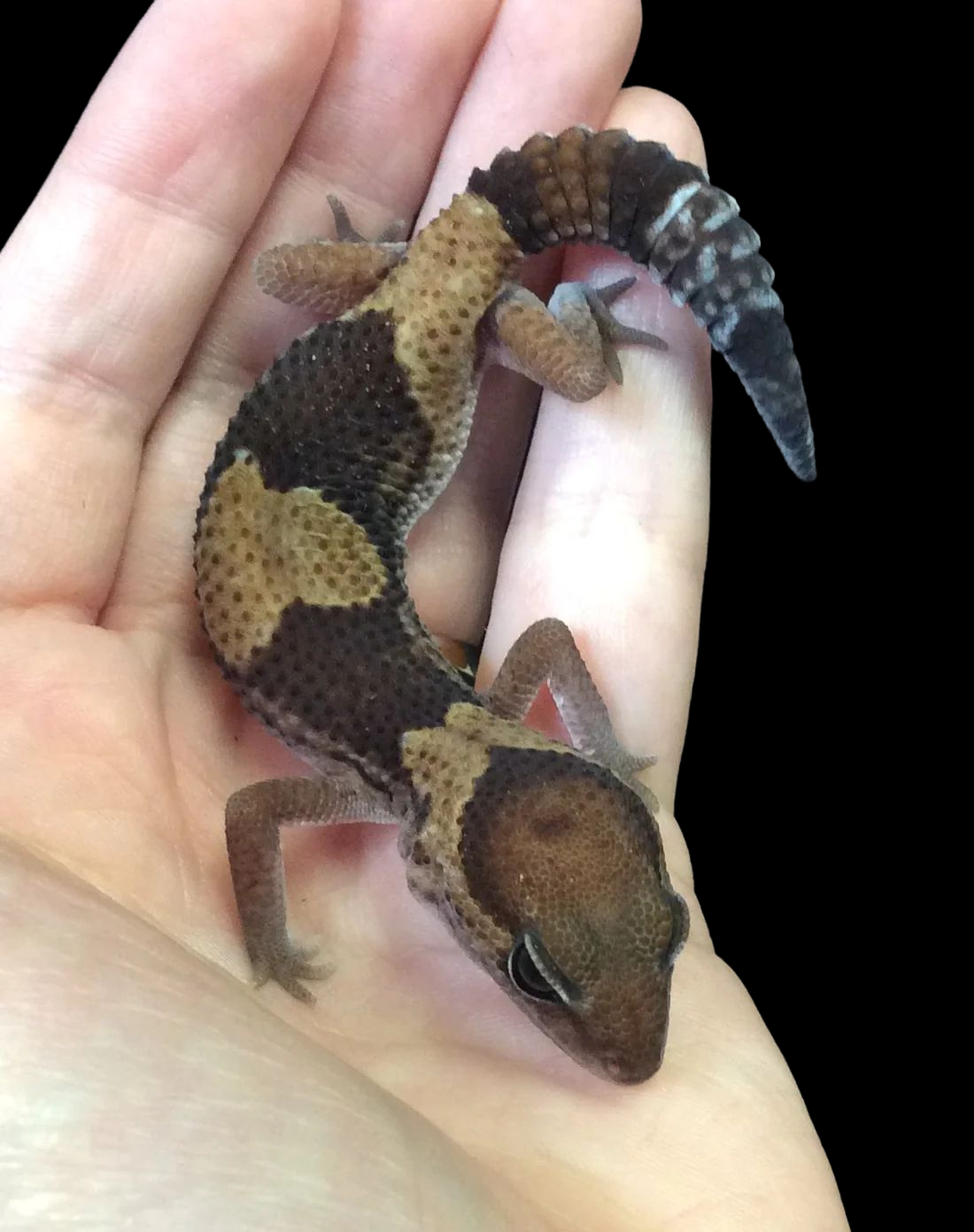Photo Disclaimer
Description
African Fat Tail Gecko (het. Oreo Patternless Stinger)
Scientific Name: Hemitheconyx caudicinctus
Common Name: African Fat Tail Gecko
Species Overview
Size: Adult African Fat Tail Geckos typically reach 7–8 inches (18–20 cm) in length, with males being slightly larger and more robust. They are stocky, ground-dwelling geckos known for their thick tails, smooth skin, and calm temperament.
Appearance: The het. Oreo Patternless Stinger African Fat Tail Gecko retains the wild-type brown and tan banding since the carried genes are not visually expressed. This combination holds strong potential for producing high-value visual offspring when bred to compatible partners, including striking dark-patterned and patternless morphs.
Distribution: Found throughout West Africa, including Senegal, Ghana, Togo, Benin, and Nigeria, where they inhabit dry savannas, scrublands, and rocky terrain.
Habitat: In the wild, these geckos prefer semi-arid environments, taking shelter in burrows or under stones during the day to escape heat. In captivity, they do best in naturalistic terrariums replicating these conditions with packed substrate, moderate humidity, and multiple hiding spots.
Behaviour: African Fat Tail Geckos are nocturnal, deliberate, and highly adaptable to captivity. They are calm by nature and tend to move slowly, making them excellent for both display and breeding collections.
Captive Care
Enclosure: A minimum enclosure size of 24 inches × 18 inches × 12 inches (60 × 45 × 30 cm) is recommended for a single adult. A naturalistic enclosure with a compact soil-sand-clay substrate encourages digging and natural movement. For younger geckos or during quarantine, reptile carpet, tile, or paper towel may be used for easier maintenance and reduced ingestion risk. Provide at least three hides—warm, cool, and humid—to support healthy shedding and thermoregulation.
Temperature & Humidity: Maintain a warm-side surface temperature between 88–92°F (31–33°C) and a cool side around 75–80°F (24–27°C). Allow nighttime drops to 70–74°F (21–23°C). Humidity should stay between 50–70%, with a damp hide for proper shedding.
Lighting: UVB lighting (2–5%) is optional but beneficial, encouraging natural rhythms and improved health. Maintain a 12-hour day/night cycle year-round.
Diet: Feed a variety of insects such as crickets, mealworms, dubia roaches, and silkworms. Supplement insects with calcium and multivitamins regularly. Juveniles should be fed daily, while adults thrive on a 2–3 day feeding schedule.
Behaviour in Captivity: These geckos are easy to manage and rarely display defensive behaviours. Once established, they are tolerant of gentle handling and thrive on consistent routines.
Special Considerations: Always use a thermostat with heat sources to prevent burns. Monitor tail fullness to gauge overall health and fat storage.
Sand: Addressing Concerns and Misconceptions
Sand has long been debated as a substrate for geckos due to the potential risk of impaction. However, when used as part of a compacted soil-sand mixture and paired with proper heating and diet, the risk remains minimal. The main issues arise from loose or calcium-based sands combined with poor husbandry. For hatchlings, juveniles, or recovering individuals, simpler substrates such as reptile carpet, tile, or paper towel are preferable until fully established.
Taxonomy Note
The African Fat Tail Gecko (Hemitheconyx caudicinctus) belongs to the Eublepharidae family, which also includes the Leopard Gecko (Eublepharis macularius). Members of this family possess eyelids and lack adhesive toe pads, making them fully terrestrial. The species exhibits stable traits throughout its West African range with minor regional variations.
Genetics Note
Oreo (Recessive): Deepens dark pigmentation, producing nearly black or high-contrast banding in visuals. Often paired with lighter genes to enhance visual contrast.
Patternless (Recessive): Removes or greatly softens visible patterning, resulting in a uniform, smooth-toned appearance. When combined with other morphs, it produces striking solid-colour variations.
Stinger (Recessive): A distinct pattern trait that modifies or elongates dorsal markings, creating a “stinger tail” or connected stripe effect in visuals. Often subtle but highly valued in combinations.
(“het.” is short for heterozygous, meaning one copy of the gene is carried but not expressed.)

